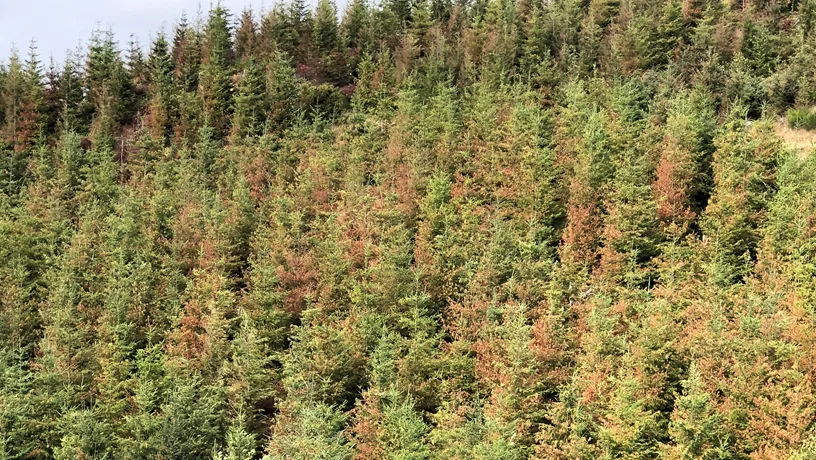PORTLAND, OR – Using satellite imagery, researchers have discovered that nearly 5% of Oregon and Washington’s western forest canopy — about the size of Rhode Island — was scorched and damaged in the multi-day 2021 heat dome.
The wave of extreme heat across the Northwest from June 25 to 29, 2021, brought the temperature in Portland to 116 degrees, killing 70 people in Multnomah County alone.
It also took a toll on the region’s forests, turning tree canopies from green to red, orange and brown within hours. That’s a sign that the leaves were scorched, healthy leaf tissue died and chlorophyll production — a pigment that gives plants their green color and helps them absorb sunlight — stopped, researchers from Oregon State University and the U.S. Forest Service found.
Their study, published Oct. 30 in the journal Global Change Biology, described it as an “unprecedented amount of foliage death.” As leaves die, trees experience acute stress that leads to slow growth, declining immunity to pests and fungus and in some cases accelerated death.
The analysis provides greater insight into how such extreme events, expected to become more common under global warming and climate change, will change the composition of the region’s western forests, as well as potentially less productive Coast Range timber farms.
Timber farms of Douglas fir and hemlocks near Florence, and near the Necanicum, Nehalem, Nestucca, Siletz and Yaquina Rivers, as well as their watersheds, experienced more acute scorching, the researchers found.
The work was led by Adam Sibley, a former postdoctoral student in plant ecophysiology at OSU, and Chris Still, a tree physiologist in OSU’s College of Forestry, along with and the National Science Foundation, the U.S. Geological Survey and the Forest Service’s Pacific Northwest Research Station funded it. Brooke Rollins, head of the U.S. Department of Agriculture, recently announced the Northwest Research Station will be closed, consolidated and moved to Colorado.
Still and researchers suggest that current models projecting how the region’s forests will continue to change under a warming climate are overly optimistic because they lack much analysis from extreme events like the heat dome.
“The heat dome was an uncontrolled test of the thermal tolerance of trees in their native environments,” Still said in a statement. “To our knowledge, there are no examples of heat wave-induced foliar death at this scale in the historical record.”
The forest canopy damage from the 2021 heat dome showed up on satellite images from southern British Columbia in Canada to as far south as Roseburg. The temperature during the dome reached 120 degrees in parts of British Columbia, clocking in as the highest temperature on record in Canada.
In western Oregon and Washington, Still and his team identified 725,368 acres — more than 1,000 square miles — of damaged tree canopy.
Those forest acres were more vulnerable to heat damage because of a number of factors the researchers identified. Among them, some were more obvious — if the trees were on a sun-facing slope or if their surroundings didn’t offer much cover from the sun. Others were less obvious. There was higher leaf scorch among trees in urban areas, agricultural valleys and forests that had burn scars from the 2020 Labor Day fires.
Different species also showed different tolerance to the heat. In general, younger trees were more vulnerable to damage than older trees, Sibley said in an email, though Older, shade-tolerant trees like western Hemlock, western red cedar and Sitka spruce suffered more greatly than shade-intolerant species, such as Douglas firs, which were less impacted and more resilient to high temperatures, though that differed by location.
The shade-tolerant species likely evolved a lower threshold for heat and for damage to systems needed for photosynthesis and other cellular structures, the researchers suggest, and are less able to resist wilting caused by uncontrolled transpiration — the process by which water moves through a plant.
Douglas fir trees, which typically experienced the most extreme temperatures at higher elevations, were less sensitive to the heat. That’s in part because the trees are used to regrowth after fire.
Tree height, whether trees were experiencing multiple stressors such as fungus or drought and the timing and pattern of when trees’ dormant buds open and begin to grow also played a part.
This story was originally produced by Oregon Capital Chronicle, which is part of States Newsroom, a nonprofit news network which includes Washington State Standard, and is supported by grants and a coalition of donors as a 501c(3) public charity.
Washington State Standard is part of States Newsroom, a nonprofit news network supported by grants and a coalition of donors as a 501c(3) public charity. Washington State Standard maintains editorial independence. Contact Editor Bill Lucia for questions: info@washingtonstatestandard.com.





